
table of contents
- 26 recommended climbing plants for bees
- Plants from A - D
- Plants from E - H
- Plants from I - R
- Plants from P - Z
- frequently asked Questions
At this point we present 26 bee-friendly climbing and climbing plants that provide insects with valuable sources of nectar and pollen from spring to autumn. Some plants need a lot of space, others also thrive on the balcony.
In a nutshell
- many domestic climbing plants are valuable bee pastures
- Insects also like to accept some exotic plants
- good forage plants should have simple flowers and little cultivation
- Wild or wild animals are particularly suitable Original forms
- some climbing and climbing plants stay low and are also suitable for the balcony
26 recommended climbing plants for bees
When choosing suitable climbing and climbing plants, make sure that you do as much as possible
- domestic
- and species that have not been cultivated much in terms of breeding
- as well as varieties with single flowers
to select. Combine these with other valuable plants such as spring, summer and autumn flowers to provide food for the insects all year round. It becomes difficult for the animals especially in early spring and from late summer when only a few plants bloom.
Plants from A - D
Alpine clematis (Clematis alpina)
The very robust alpine clematis belongs to the clematis species that open their flowers at an early stage in the year.
- Location: partially shaded or shady
- Soil: sandy to loamy, fresh to moist
- Height: up to three meters
- Flower shape: simple bell flowers
- Flowering period: May to June
- Flower colors: purple, blue
- Use: privacy screens, wall, wall and fence greening, also for planters
- Special features: native wild plant
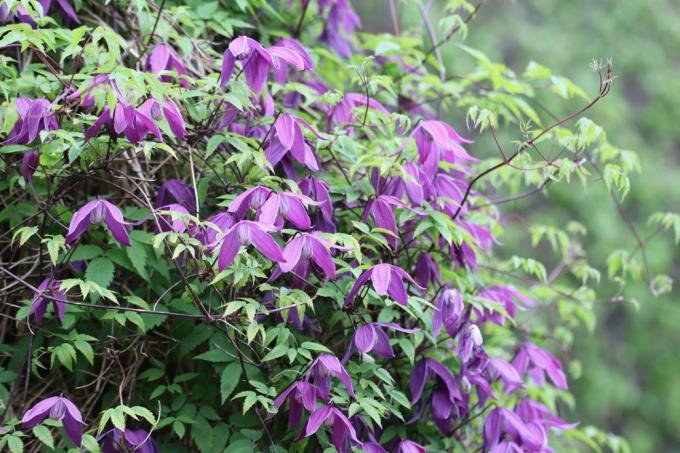
Broad-leaved pea (common vetch, Lathyrus latifolius)
There are around 160 different types of flat peas or peas. Sweet peas. Particularly bee-friendly species are the annual scented vetch (Lathyrus odoratus) and the perennial vetch (Lathyrus latifolius), which is also described here. Flat peas are valuable food crops for bees and many other insects.
- Location: sunny to partially shaded
- Soil: rather dry, calcareous
- Annual or perennial: perennial
- Growth height: up to 200 centimeters
- Flowering period: June to August
- Flower colors: red, pink, purple, white
- Use: climbing plants for fences
- Special features: many native species, e.g. B. Yellow pea, forest pea, red pea, naked pea

Blackberry (Rubus)
The blackberry, which belongs to the rose family (Rosaceae), is one of the most popular types of fruit. The thorny tendrils can be several meters long, so that impenetrable hedges quickly form. In the case of insects and other animals, however, the plants are very popular as fodder plants and hiding places.
- Location: sunny to partially shaded
- Soil: rich in humus, calcareous
- Annual or perennial: perennial
- Growth height: up to 500 centimeters
- Flower shape: simple
- Flowering period: June to July
- Flower colors: white
- Special features: edible fruits
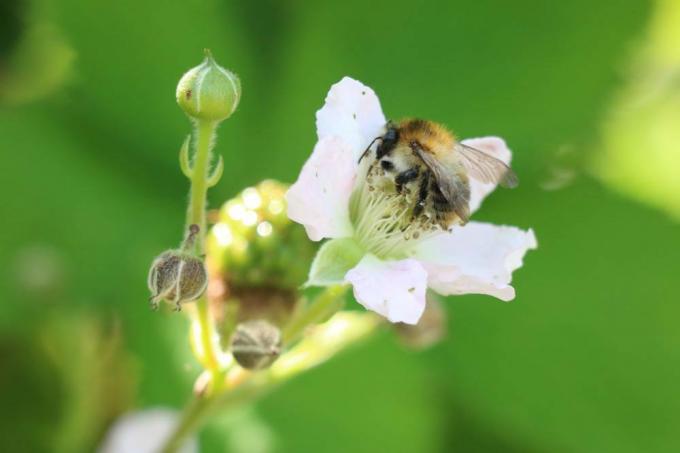
Chinese wisteria (Wisteria sinensis)
The hanging, very lush growing wisteria impresses with its beautiful flowers. They are rich in nectar and pollen, which is why the bee-friendly plants are often planted in the garden. But be careful: all parts of the plant are poisonous to humans and pets.
- Location: sunny to shady
- Soil: rich in nutrients
- Annual or perennial: perennial
- Height: up to 15 meters
- Flower shape: grape blossoms
- Flowering period: May to June
- Flower colors: purple, white
- Use: wall and wall greening
- Special features: poisonous

Plants from E - H
Ivy (Hedera helix)
Due to its late blooming period, the native ivy is a coveted and popular herb for bees and many other insects. In particular, old ivy stocks should therefore not be removed, but rather preserved if possible.
- Location: shady to shady
- Soil: rich in nutrients, calcareous
- Annual or perennial: perennial
- Height: up to 20 meters
- Flower shape: inconspicuous umbellate flowers
- Flowering period: September to October
- Flower colors: greenish-white
- Use: ground cover, surface and wall greening
- Special features: evergreen, poisonous

Earth pear (Apios americana)
The bee-friendly earth pear comes from North America and is one of the rather unknown climbing plants in this country. Their tubers, which grow underground, are edible and have a taste reminiscent of sweet potatoes.
- Location: sunny to partially shaded
- Soil: rich in humus
- Growth height: up to three meters long tendrils
- Flowering period: August
- Use: in stand-alone position, requires climbing aids (e.g. pergolas or trellises)
- Special features: edible tubers, sprouts anew every year

Haricot beans (Phaseolus)
The kidney beans, which are highly valued as a vegetable, are annual climbing plants, the flowers of which are very popular with bees as a source of food. With the cultivation of Runner beans or firebeans So not only do yourself a favor, but also a lot of insects.
- Location: sunny, warm, sheltered from the wind
- Soil: rich in humus, loose
- Annual or perennial: annual
- Flowering period: May to June
- Use: with climbing support in the vegetable garden, on fences
- Special features: edible legumes

Garden peas (Pisum sativum)
Annual climbing plants are among the oldest food plants in the world. The same applies to them as to beans: with the cultivation of these plants you feed yourself and your family as well as bees and other humming people.
- Location: sunny
- Soil: rich in humus, loose
- Annual or perennial: annual
- Growth height: up to three meters long tendrils, depending on the variety
- Flowering period: between May and June
- Flower colors: white
- Special features: edible, forms nitrogen-collecting nodule bacteria on the roots

Honeysuckle (Jelängerjelieber, Lonicera henryi)
Bee-friendly climbing plants like the honeysuckle should not be missing in any garden - especially not when the flowers smell so wonderful not only for bees, but also for us humans.
- Location: sunny to partially shaded
- Soil: rich in humus, fresh to moist
- Height: up to six meters
- Flower shape: whiskers, strongly scented
- Flowering period: May to July
- Flower colors: white, yellow, pink
- Use: for garden fences, as wall and wall greening, privacy screens
- Special features: poisonous, valuable bird protection wood
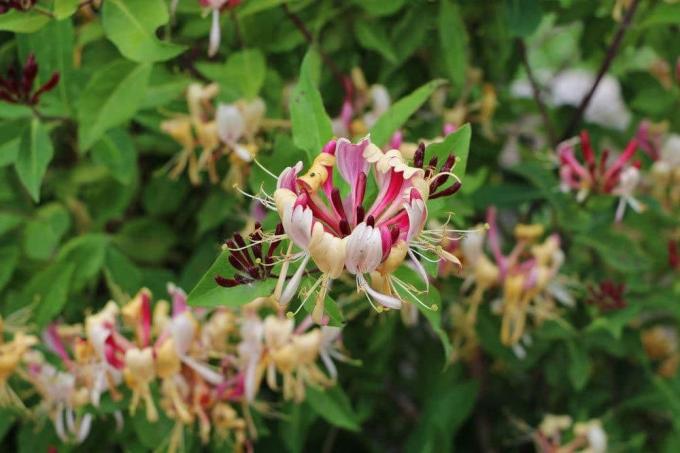
Bell vines (bell vine, Cobaea scandens)
Due to its long flowering time and the light flower scent, the bell vine is popular not only with gardeners, but also with bees. It is one of the strong-growing climbing plants that develop up to six meters long tendrils within a very short time.
- Location: sunny to partially shaded
- Soil: rich in humus, rather sandy
- Annual or perennial: annual
- Growth height: up to six meters long tendrils
- Flower shape: single bell-shaped flowers
- Flowering period: July to October
- Flower colors: white, purple, multicolored
- Use: for garden fences, as wall and wall greening, well suited for planters
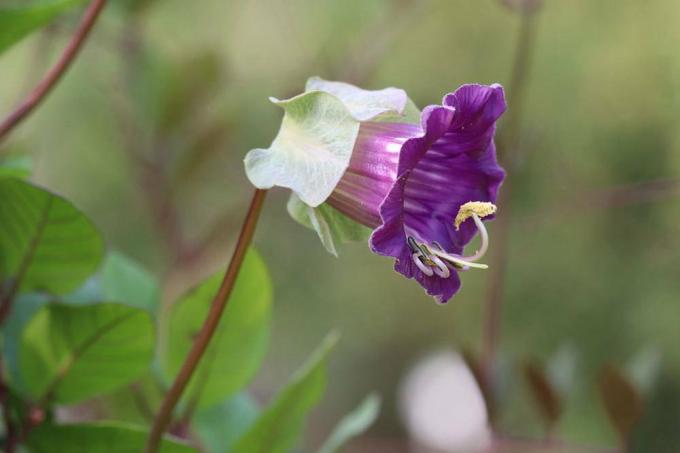
Gold clematis (Clematis tangutica)
The yellow clematis, which comes from China, is a popular, bee-friendly plant due to its long flowering time and abundance of nectar.
- Location: sunny to partially shaded
- Soil: sandy to loamy, rich in nutrients
- Height: up to three meters
- Flower shape: single bell-shaped flowers
- Flowering period: June to October
- Flower colors: yellow
- Use: for garden fences, as wall and wall greening, for individual positions

Cucumber (Cucumis sativus)
Anyone who writes about bee-friendly climbing plants and climbing plants should definitely not forget the cucumbers. The large flowers of all cucumber plants are very popular with bees and other insects, as they are rich in nectar and pollen.
- Location: full sun, sheltered from the wind
- Soil: loose, rich in humus
- Usage: free-range cucumbers in particular are bee-friendly plants that can be grown on the ground or on a trellis
- Special features: edible fruits

Plants from I - R
Italian clematis (Clematis viticella)
The Italian clematis are wild forms that are much more robust than the better-known clematis hybrids. There are also various bee-friendly varieties of this species with beautiful flowers.
- Location: sunny to partially shaded
- Soil: nutrient-rich, fresh to moist
- Growth height: up to five meters, growing upright
- Flower shape: cup-shaped flowers
- Flowering period: June to September
- Flower colors: white, red, pink, purple, blue
- Special features: hardy
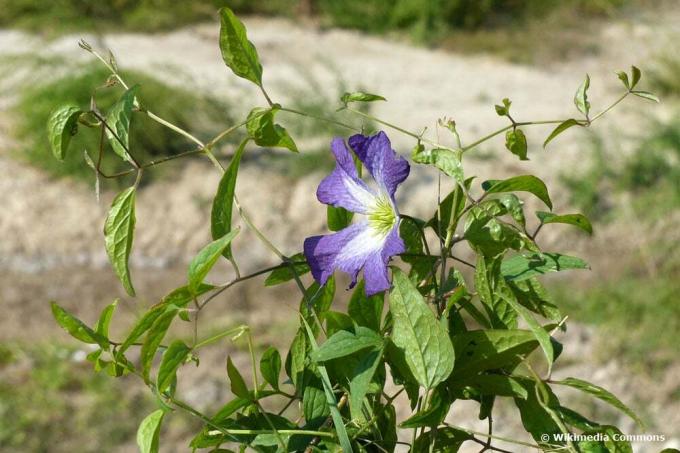
Nasturtium (Tropaeolum)
Those who cultivate the flowering, large nasturtium in their garden, opt for climbing plants that are particularly rich in vines. The beautiful flowers in sunny colors are easy to reach for bees and are also rich in nectar and pollen.
- Location: sunny to partially shaded
- Soil: sandy to loamy
- Annual or perennial: annual
- Growth height: up to 30 centimeters
- Flower shape: large single flowers
- Flowering period: July to October
- Flower colors: red, orange, yellow, multicolored
- Special features: edible flowers
Tip: Species and varieties of nasturtiums that remain low are also suitable for balcony cultivation.

Climbing hydrangea (Hydrangea petiolaris)
The climbing hydrangea climbs walls and walls, which it soon covers over a large area with its tendrils. The climbing plants are also adorned with large, creamy white and fragrant inflorescences that attract insects of all kinds.
- Location: sunny to shady
- Soil: rich in nutrients, low in lime
- Annual or perennial: perennial
- Height: up to 15 meters
- Flower shape: panicles
- Flowering period: June to July
- Flower colors: creamy white
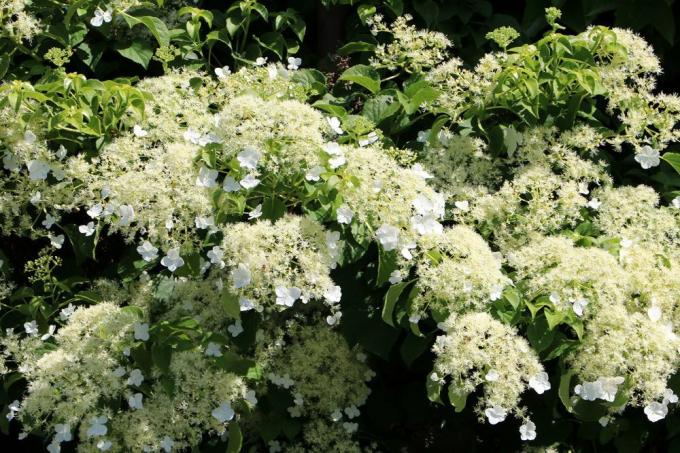
Climbing roses (pink, unfilled varieties)
The popular climbing roses are also particularly bee-friendly climbing roses, provided they are varieties with simple, unfilled flowers (e. B. 'Dortmund' or 'Bobby James'). These plants embellish house walls, pergolas, rose arches and even trees.
- Location: sunny
- Soil: nutrient-rich, loose
- Annual or perennial: perennial
- Height: up to ten meters, spreading climbers (need climbing aid)
- Flowering period: multiple flowers (climbing roses), single flowering (rambler roses)
- Flower colors: white, yellow, red, pink, apricot
- Special features: Differentiation between climbing and rambler roses, the latter are very vigorous
Tip: In addition to climbing roses, wild roses such as the vinegar rose (Rosa gallica) or the Bibernell rose (Rosa pimpinellifolia) are valuable bee pastures.
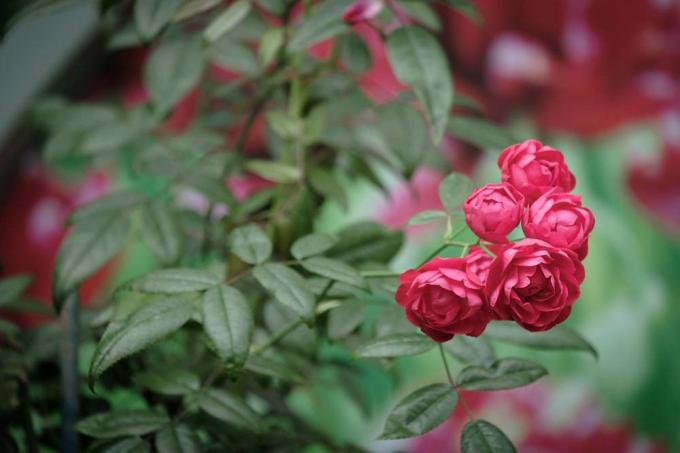
Climbing Trumpet (Campsis radicans)
The climbing trumpet, also known as the trumpet flower, has a very exotic effect due to its large calyxes, but it is also hardy with us.
- Location: sunny
- Soil: loamy and humus-rich, moderately dry to fresh
- Annual or perennial: perennial
- Height: climbing plants up to ten meters high
- Flower shape: trumpet flowers
- Flowering period: July to September
- Flower colors: red, orange, yellow
- Use: wall greening, good companion for roses
- Special features: vigorous, forms adherent roots
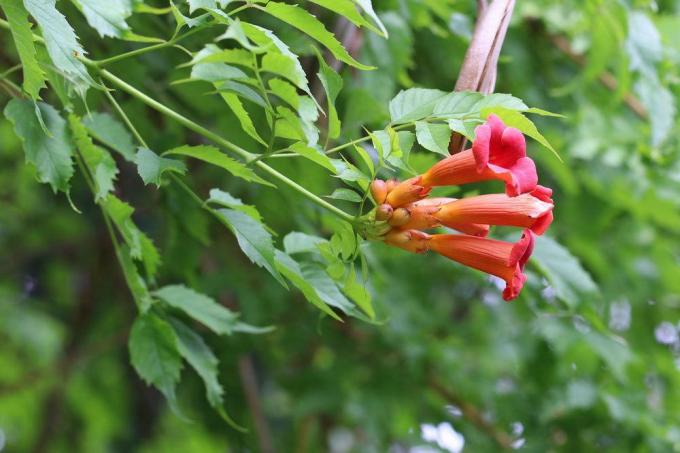
Creeping rose (Rosa arvensis)
The creeping rose, also known as the field rose, is a native wild rose species that provides plenty of valuable nectar and pollen for bees and other insects. It is a ground cover, but it takes every opportunity to climb.
- Location: sunny to partially shaded
- Soil: rich in humus, loose
- Annual or perennial: perennial
- Height: up to two meters
- Flower shape: simple
- Flowering time: depending on the species, April to May or June to July
- Flower colors: white
- Use: Planting the edges of trees
Tip: If you prune the creeping roses every year, they will bloom all the more profusely.

Pumpkin (cucurbita)
Like the related cucumbers are other cucurbits - including edible and ornamental gourds, and zucchini Melons - bee-friendly climbing and climbing plants whose large flowers provide plenty of food for insects Offer. Therefore, they should not be omitted from this list.
- Location: sunny
- Soil: nutrient-rich, loose
- Annual or perennial: annual
- Growth height: up to several meters long tendrils, depending on the species and variety
- Flower shape: large funnel-shaped flowers
- Flower colors: yellow
- Use: in vegetable patches, but also for compost greening and on walls and fences
- Special features: edible fruits

Plants from P - Z
Passion flowers (Passiflora)
Passion flowers are not hardy with us and can therefore only be kept in pots. Still, these climbing plants are very popular with bees.
- Location: sunny
- Soil: container plant substrate, moist, but no waterlogging
- Annual or perennial: Winter perennial, frost-free
- Growth height: up to several meters in height
- Flower shape: characteristic
- Flower colors: mostly violet-white
- Use: container plant
- Special features: edible fruits
Tip: In particular, maracuja or passion fruit (Passiflora edulis), which you can easily grow from the seeds of supermarket fruit, are very suitable as a bee-friendly balcony plant.

Knotweed (Fallopia baldschuanica)
The knotweed is a valuable wood for large gardens, on which many animals feed and live in it. In addition to bees, these plants also provide food and shelter for birds and small animals. But be careful: knotweed is extremely vigorous and overgrows open spaces in no time at all - it is not without reason that it is nicknamed "Architect's comfort".
- Location: sunny to partially shaded
- Soil: rich in humus
- Height: up to 15 meters
- Flower shape: slightly fragrant panicles
- Flowering period: June to October
- Flower colors: white, yellow, white
- Special features: extremely vigorous

Black-eyed Susan (Thunbergia alata)
One of the most popular climbing plants in the garden thanks to its pretty flowers and dark green leaves. The species can also be cultivated very well in pots.
- Location: sunny
- Soil: rich in humus, calcareous
- Annual or perennial: annual
- Height: up to one and a half meters
- Flower shape: funnel-shaped single flowers
- Flowering period: June to October
- Flower colors: white, yellow, orange, multicolored
- Use: for flower beds, garden fences, planters
- Special features: sensitive to frost
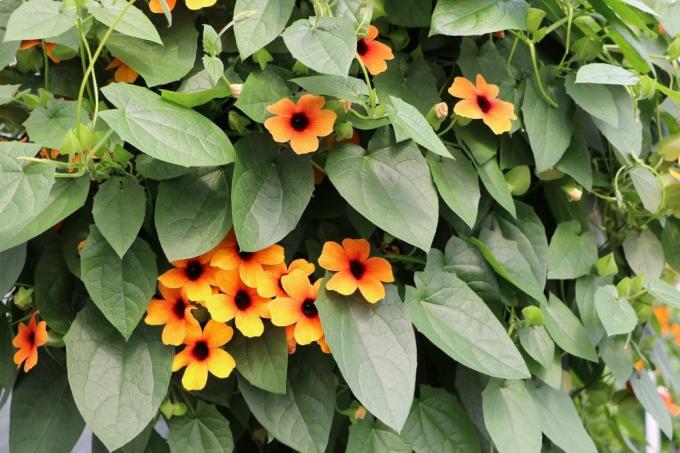
Morning Glory (Morning Glory, Ipomoea)
The funnel wind, also known as morning glory or morning glory, originally comes from Central America. The actually perennial plants are not hardy here and are therefore only cultivated as an annual.
- Location: sunny
- Soil: nutrient-rich, moist
- Annual or perennial: annual
- Height: up to four meters
- Flower shape: funnel-shaped flowers
- Flowering period: July to October
- Flower colors: blue, white, pink, multicolored
- Special features: needs climbing aids

Wild grape (virgin vine, Parthenocissus tricuspidata)
The wild wine is undoubtedly one of the most important nectar and pollen plants in the garden. Here it hums and hums not only during the flowering period, but all summer long.
- Location: sunny to partially shaded
- Soil: rich in nutrients
- Annual or perennial: perennial
- Height: up to 20 meters
- Flowering time: white
- Flower colors: July to August
- Special features: has adhesive discs, self-climbing
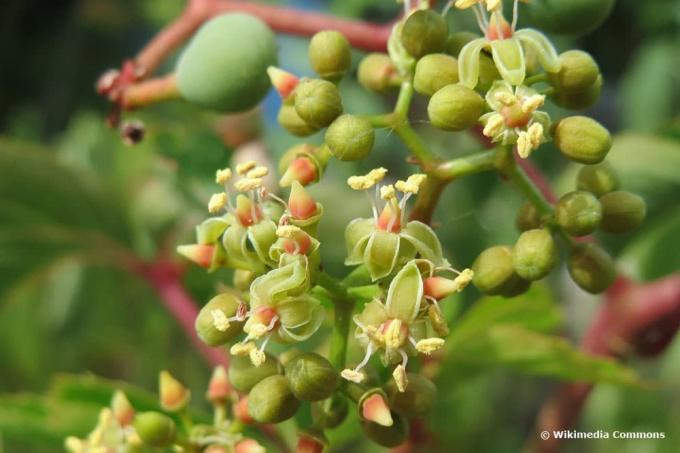
Winter jasmine (Jasminum nudiflorum)
Because of its extremely early flowering period, winter jasmine is an important and valuable herb for bees, bumblebees and other insects that wake up early from hibernation.
- Location: sunny to partially shaded
- Soil: nutrient-rich, lime-loving
- Annual or perennial: perennial
- Growth height: up to three meters high
- Flower shape: single flowers
- Flowering period: January to March
- Flower colors: yellow
- Special features: overhanging growth

Bryonia
The bryony is a wild plant native to us that has a strong vine and is widespread. The species that can be found in our country are red-fruited bryony (Bryonia dioica) and white bryony (Bryonia alba) are valuable forage plants, especially for wild bees, but the berries in particular are strong poisonous.
- Location: sunny to partially shaded
- Height: up to three meters
- Flower shape: simple
- Flowering period: June to September
- Flower colors: white
- Use: perfect for planting on the edge of the wood
- Special features: highly poisonous
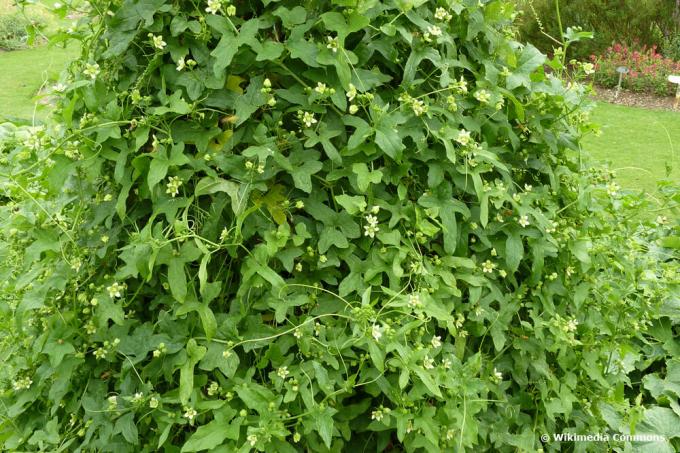
frequently asked Questions
Almost all plants with simple, unfilled flowers and little cultivation are bee-friendly. For a natural, insect-friendly garden, therefore, prefer local flowers, shrubs and shrubs. Herbs and wild flowers such as yarrow, wild mallow, dost and borage are particularly popular. But also nasturtiums, sunflowers and numerous other spring and summer flowers are popular with bees.
Bees are irresistibly drawn to the color yellow. Blue and purple flower colors are also irresistible to the insects, which is why bee-friendly plants often bloom in these colors or a combination thereof.
Bees literally starve to death in front of a set table when they plant flowers with double blossoms (e. B. Roses, dahlias etc.) or cultivars that have been heavily cultivated such as geraniums, petunias or pansies. The latter contain little or no nectar and are therefore ecologically worthless.



